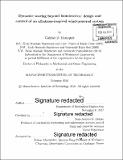Dynamic soaring beyond biomimetics: control of an albatross-inspired wind-powered system
Author(s)
Bousquet, Gabriel D
DownloadFull printable version (40.61Mb)
Other Contributors
Massachusetts Institute of Technology. Department of Mechanical Engineering.
Advisor
Jean-Jacques E. Slotine.
Terms of use
Metadata
Show full item recordAbstract
Albatrosses extract their propulsive energy from horizontal winds in a maneuver called dynamic soaring, and travel impressive distance (5000 km/week) by "riding the winds". Accordingly, for albatrosses flight is barely more strenuous than rest. While thermal soaring, exploited by birds of prey and sports gliders, consists of simply remaining in updrafts, extracting energy from horizontal winds necessitates redistributing momentum across the wind shear layer, by means of an intricate and dynamic flight manoeuver. Historically, dynamic soaring has been described as a sequence of half-turns connecting upwind climbs and downwind dives through the surface shear layer. Relaxing the half-turn hypothesis, this thesis numerically and analytically studies the "minimum-wind" problem i. e. the question of how much wind is required to stay aloft with dynamic soaring, and what is the optimal flight strategy to do so. Contrary to current thinking, but consistent with GPS recordings of albatrosses, it is shown that when the shear layer is thin the optimal trajectory is composed of small-angle, large-radius arcs. Essentially, the albatross is a flying sailboat, sequentially acting as sail and keel, and most efficient when remaining crosswind at all times. The thin-shear analysis is then extended asymptotically, predicting in closed-form the most efficient dynamic soaring trajectory in wind shears of finite thickness. Building upon the conceptual study of dynamic soaring, a robotic system inspired by the albatross is proposed: the "flying sailboat", i. e. a low-flying, water-skimming airplane powered by a keel-and-sail combination. Potentially, the flying sailboat could travel 10x faster than a traditional sailboat of the same size, survive in much rougher seas than hydrofoil boats, and carry 10x more payload than a naive robotic copy of the albatross. A mechanical prototype is presented, with the keel and height controlled with feedback-linearization controllers. Experimental results demonstrating the critical aspects of the system's operation and control are reported: stable extreme-low height flight concurrent with controlled keel immersion and force generation.
Description
Thesis: Ph. D. in Mechanical and Ocean Engineering, Massachusetts Institute of Technology, Department of Mechanical Engineering, 2018. Cataloged from PDF version of thesis. Includes bibliographical references (pages 164-172).
Date issued
2018Department
Massachusetts Institute of Technology. Department of Mechanical EngineeringPublisher
Massachusetts Institute of Technology
Keywords
Mechanical Engineering.